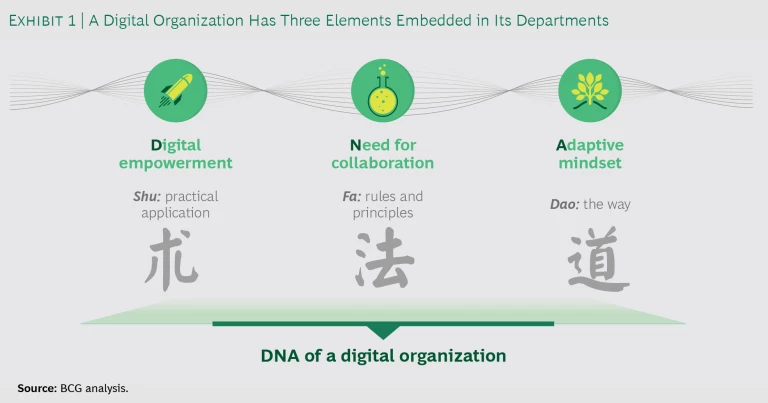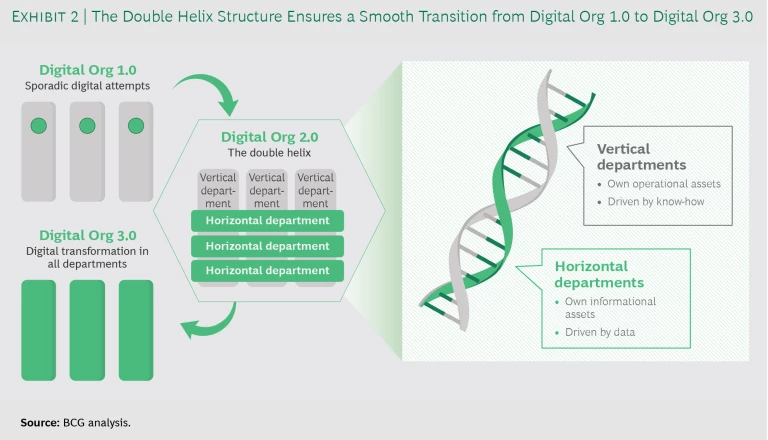The digital age is here, but is your organization digitally ready?
When you think of digital transformation, you may think of upgrading your IT infrastructure, conducting digital pilots, running customer journeys, and so on. But to unlock the full potential of digital, you need to embed digital elements in your organization from top to bottom and side to side. Three elements form the “digital DNA” of an organization:
- Digital Empowerment. Companies must break down the silos that keep data pools isolated from one another. They need to create a common data set that artificial intelligence and big data analytics can shape into insight and value.
- Need for Collaboration. When they are digitally empowered, companies can meet ever-changing market and customer needs more easily, but only if they encourage the cross-departmental collaboration characteristic of agile and other digitally oriented ways of working.
- Adaptive Mindset. It takes more than technology to bring digital businesses to life. Leadership and employees need to be forward-thinking and innovative so that their organizations can thrive in an unpredictable business environment.
These elements and the relationship among them recall basic concepts of ancient Chinese philosophy. Digital empowerment is shu, or practical application. The need for collaboration is fa, the rules and principles required of society. The adaptive mindset is dao, or the “way” that gives individuals a path to follow. In ancient times, dao guided shu (the way guided action) and fa fortified dao (principles strengthened the path). Today, a digital mindset guides action, and collaboration helps to ensure that the whole is greater than the sum of the parts. All the elements matter in creating a successful digital transformation. (See Exhibit 1.)
How to Transform?
In digital transformation, it’s hard to get the right balance between speed and scale. If a company moves too slowly, it may drown in a digital ocean of data and tools and have difficulty achieving business results; if it moves too quickly, it runs the risk of piecemeal effects.
Some companies in traditional industries have a weak digital foundation. Often, they have not adopted cloud computing at scale and may still rely on some manual, offline business processes. Their customers may be more advanced than they are, creating a gap between digital supply and demand.
Many companies have successfully transformed by setting up a new type of department, a horizontal organization that cuts across and collaborates with such vertical areas as product development, marketing, and sales. Rather than owning financial or operational assets, these departments own informational assets—operating data, customer insights , and other intangible property that data analytics brings to life. They are data driven. Their primary purpose is to empower traditional vertical departments with digital tools and capabilities and to nurture a digital mindset throughout the organization. They work closely with the vertical departments, which continue to contribute their business know-how, financial resources, and human capital.
As collaboration deepens, these horizontal departments become intertwined with the vertical departments in a manner similar to the strands of DNA’s double helix. (See Exhibit 2.) We call this horizontal and vertical structure “digital org 2.0.” It allows digital DNA to be injected into what had been a largely analog organization. Digital org 2.0 is an intermediate and enabling step between digital org 1.0, marked by scattered attempts at digitalization, and digital org 3.0, in which the entire organization has gone digital.
How exactly can this digital gene transfer translate into business results? That’s where digital empowerment, the need for cooperation, and an adaptive mindset enter the scene. Collectively, they are the organization’s DNA.
Digital Empowerment
Without a common data language, departments are unable to unlock the power of information and analytics.
Recognizing this shortcoming, many Chinese companies in consumer goods, retail, and industrial goods have adopted the horizontal “data middle office” concept pioneered by internet giant Alibaba. For example, a leading Chinese dairy company had accumulated vast quantities of data after years of operation, but because the data was scattered throughout the organization the company could not take full advantage of it. The company established a data middle office responsible for connecting and integrating customer and operational data across all vertical business units. With data mining and advanced-analytics capabilities centralized, the horizontal department was able to generate valuable business insights that empowered vertical departments such as product development, marketing, and sales.
Need for Collaboration
How can companies activate this interdepartmental collaboration in the digital age?
Many companies have successfully transformed by setting up a horizontal organization that cuts across and collaborates with such vertical areas as product development, marketing, and sales.
Again the answer is a horizontal department. Automakers in China realized that they lacked a unified, cross-functional customer operations process to manage customer acquisition, activation, retention, conversion, and referral. Customers had an inconsistent experience, and automakers were leaving money on the table. In response, one automaker established a horizontal department responsible for customer operations across all digital touch points, including mobile apps, WeChat, and the brand’s official social network accounts. Responsibility for these activities had been shared across marketing, sales, and aftersales departments. With the horizontal department collecting rich data across all these departments, the company was able to identify new business opportunities.
By triggering reactions across vertical departments, the horizontal department catalyzed collaborative customer operation initiatives and the capture of customer life cycle value. The automaker adopted such practices of Chinese internet companies as structured job rotation, enhanced communication and engagement, and a commitment to purpose. These practices helped employees focus on continuous customer value creation and fostered collaboration.
Adaptive Mindset
In addition to fostering digital empowerment and cross-departmental collaboration, organizations must cultivate an adaptive mindset. Being adaptive means having a forward-looking perspective that allows for sustained innovation through trial and error in a fast-changing environment. How can organizations foster this mindset?
More than a decade ago, a leading financial conglomerate in China sensed the need for digital and technological innovation and greater adaptiveness. To cultivate that adaptive mindset amid changing market conditions and customer expectations, it established a technology department to serve as a horizontal nerve center.
The primary purpose of the horizontal organization is to empower traditional vertical departments with digital tools and capabilities and to nurture a digital mindset throughout the organization.
This department, committed to researching and developing cutting-edge technologies, is responsible for applying research-based insights to frontline businesses and nurturing a digital and adaptive way of thinking. With such a clear focus, the department foresaw the potential applications of AI in securities investment before many other financial institutions. The department also played the role of a digital incubator. It established a project team consisting of employees from several vertical departments to work full time on innovative projects. The team developed smart investment tools and applied them to front-end businesses, spreading innovative digital products and a digital mindset across multiple vertical departments.
Journey Ahead
Is a company really digital once these horizontal departments are set up? Far from it. First, there are likely to be competing forces as the two types of departments interact. Leaders must manage both the vertical and horizon departments to ensure integration rather than competition. Performance management must also be fine-tuned to encourage collaboration. Organizations will need to hire talent who know the technology and, equally important, can cooperate with business executives and speak their language. Finally, a digital organization can only go as far as its customers, partners, and vendors will allow. It takes an ecosystem.
Organizations without digital DNA cannot thrive in the digital age; they may not even survive. While these horizontal departments are not a panacea, they will allow digital empowerment, the need for collaboration, and an adaptive mindset to take root. As the two strands of an organization’s DNA wind around each other, they encourage the creation of a future-ready digital organization.










